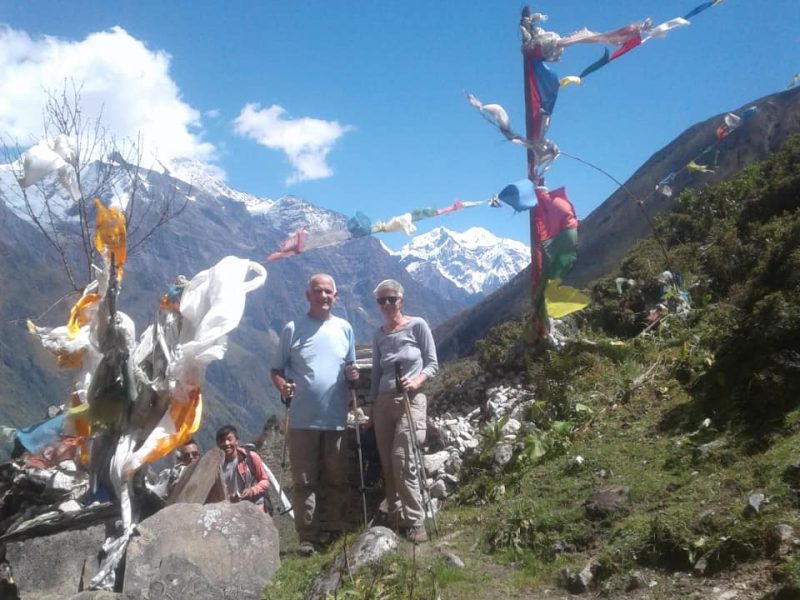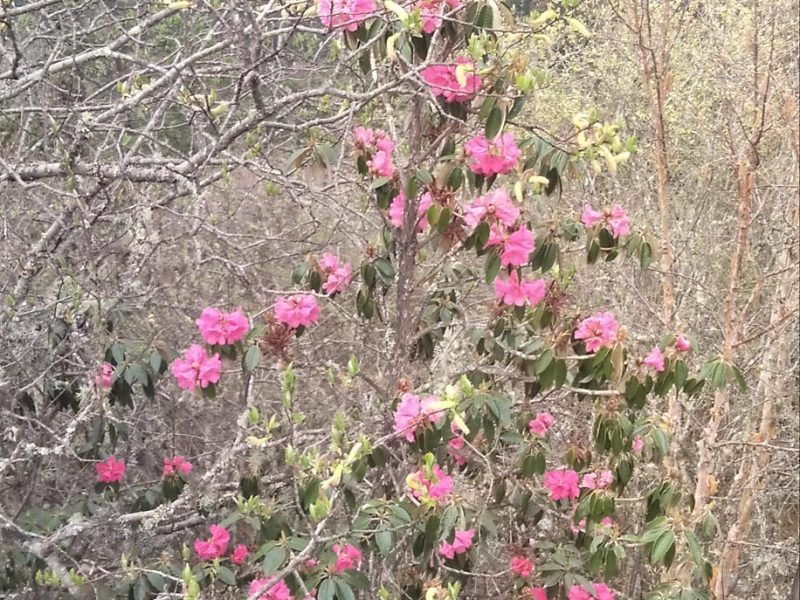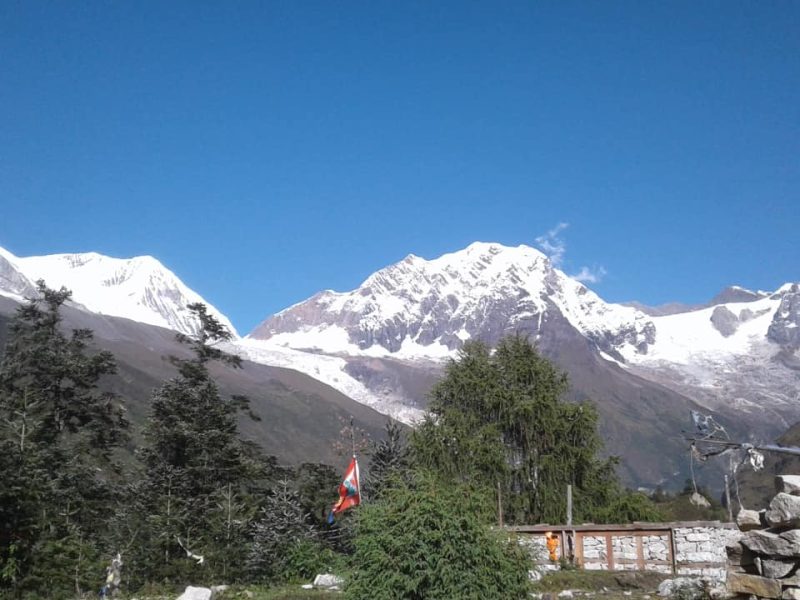
The Manaslu Circuit Trek is one of the most beautiful and adventurous treks in Nepal. It takes you around Mount Manaslu (8,163 m), the eighth-highest mountain in the world. The trail begins in the lower hills of Gorkha and slowly climbs through lush forests, deep valleys, and remote villages before crossing the high Larkya La Pass (5,106 m). Along the way, trekkers experience changing landscapes—from green rice fields to rocky cliffs and snowy peaks. Because the route makes a full circle around the mountain, it is called a “circuit trek.”
What makes the Manaslu Circuit Trek special compared to other treks is its remoteness and peaceful environment. Unlike the crowded Everest Base Camp or Annapurna Circuit, this trail is much quieter, with fewer trekkers. It gives you the chance to see an authentic side of Nepalese life, as many villages here still follow traditional ways of living. You can walk through Tibetan-style villages, Buddhist monasteries, and old mani walls while enjoying spectacular Himalayan views. The feeling of walking in such untouched landscapes makes the trek a unique adventure.
Another important feature of the trek is the wildlife and culture you experience along the way. The route goes through the Manaslu Conservation Area, which is home to rare animals like the Himalayan tahr, blue sheep, and even the elusive snow leopard. You may also spot colorful Himalayan birds like the Danphe, Nepal’s national bird. At the same time, the local people—mainly Gurung and Tibetan communities—welcome trekkers with their warm culture, festivals, and traditions. Together, the rich wildlife and vibrant culture make the Manaslu Circuit Trek more than just a mountain journey—it is a deep and unforgettable Himalayan experience.
The Manaslu Conservation Area (MCA) is a protected region in the Himalayas of Nepal. It was established to look after both nature and culture in the Manaslu region. The area covers beautiful mountains, rivers, forests, and remote villages. Trekkers who visit the Manaslu Circuit Trek pass through this conservation area, which makes the journey even more special. The MCA is famous for its clean environment, peaceful trails, and the warm hospitality of local people.
The Manaslu Conservation Area is home to rare animals and plants such as the snow leopard, Himalayan tahr, red panda, and colorful Himalayan birds like the Danphe (national bird of Nepal). The forests are filled with rhododendron, pine, and alpine herbs. Besides wildlife, the MCA also protects local traditions and cultural heritage. The villages here are rich in Tibetan-influenced culture, monasteries, festivals, and farming lifestyles. By protecting both nature and culture, the MCA helps keep the Manaslu region authentic and beautiful for future generations.
Every trekker has an important role in protecting the Manaslu Conservation Area. Trekkers must get special permits (Restricted Area Permit, MCAP, and Annapurna Conservation Area Permit) before entering. These permits not only allow trekking but also provide funds to support conservation projects and local communities. Responsible trekking means carrying reusable water bottles, respecting local traditions, not littering, and staying in local tea houses that follow eco-friendly practices. By trekking responsibly, visitors help keep the Manaslu region a true natural haven.
The Manaslu Conservation Area is home to many fascinating animals that make the trek special. Common wildlife you may see includes the Himalayan tahr, a wild goat with thick brown fur, and the blue sheep, which often graze on high slopes. Trekkers may also spot musk deer, known for their long teeth, playful langurs (monkeys), and the colorful Himalayan monal (Danphe), which is Nepal’s national bird. Seeing these animals in their natural home adds excitement to the journey and makes the trek feel closer to nature.
Apart from common species, Manaslu is also famous for its rare and endangered animals. If you are lucky, you might catch signs of the snow leopard, a shy but powerful predator of the high Himalayas. Another special resident is the red panda, a small, cute, and tree-loving animal that lives in the forests. Both species are very difficult to spot, but knowing that they live in this region makes the trek even more meaningful. Protecting these endangered animals is one of the main goals of the Manaslu Conservation Area.
The region is also rich in birdlife diversity. More than 100 species of birds have been recorded here, including eagles, vultures, and pheasants. Spring and autumn are the best seasons for spotting wildlife, as animals and birds are more active, and the forests are full of life. In winter, many animals move to lower altitudes, while in summer (monsoon), dense forests and rain can make sightings difficult. For trekkers who enjoy nature, the Manaslu Circuit offers not just mountains and culture, but also a living paradise of wildlife.

The Manaslu Circuit Trek is not only famous for its high mountains and remote villages, but also for its amazing natural beauty. As you walk along the trail, you pass through thick rhododendron forests, tall pine trees, and juniper groves. Higher up, the land changes into alpine meadows filled with tiny herbs and wildflowers. These green and colorful landscapes make the journey peaceful and refreshing for trekkers. The forests are also home to many birds and animals, adding life and charm to the trekking experience.
The Manaslu region is also rich in medicinal plants. Local people have been using these herbs for generations as natural remedies. For example, they use herbs to cure headaches, stomach problems, or even to boost energy during long walks. These plants are not only part of their daily life but also show the deep connection between nature and culture in this area. Trekkers often find it fascinating to learn how locals depend on the forest for medicine, firewood, and food while still protecting their natural environment.
The beauty of the Manaslu Circuit changes with the seasons. In spring, the rhododendrons bloom in bright red, pink, and white colors, covering the hills like a colorful carpet. This makes spring one of the most beautiful times to trek. In autumn, the skies are clear and the forests turn golden, offering breathtaking mountain views and warm landscapes. Each season brings a different kind of beauty, making the Manaslu Circuit Trek a truly magical experience.
When you trek around the Manaslu Circuit, you will meet different ethnic groups such as the Gurung, Tibetan, and Nubri people. These communities have lived in the high Himalayas for centuries, and their traditions make the region very special. The Gurung people are known for their bravery and rich culture, while the Nubri and Tibetan people have strong ties to Buddhism. As you walk through villages, you will see people dressed in traditional clothes, speaking local languages, and following customs that have been passed down through generations. This cultural mix makes the trek not only about mountains but also about people.
The lifestyle of the locals is very simple and connected to nature. Most families depend on farming, animal husbandry, and yak herding. In the fields, they grow crops like barley, buckwheat, and potatoes, which are the main food in the highlands. Yaks and sheep provide milk, butter, cheese, and wool, which are very important for survival in the cold climate. When you visit these villages, you can also see locals spinning wool, making handicrafts, and cooking traditional food. Their way of life shows how people can live happily and sustainably in such remote areas.
The villages on the Manaslu trail are full of unique and traditional architecture. Most houses are made of stone and wood, which keep them warm during the cold months. Along the paths, you will notice mani walls, chortens (Buddhist shrines), and ancient monasteries decorated with colorful prayer flags. These structures are not just beautiful but also show the deep spiritual connection of the people with Buddhism. The architecture, combined with the mountains in the background, creates a magical scene for trekkers.
The Manaslu Circuit Trek is not just about mountains and scenery; it is also a journey into the heart of Buddhist culture. Buddhism plays a very important role in the daily life of people living in the Manaslu region. Villages are decorated with prayer flags, mani walls (stone walls carved with prayers), and spinning prayer wheels. These symbols remind trekkers that the region is deeply spiritual, and that faith is closely tied to the way people live. For trekkers, walking through these areas feels peaceful and offers a chance to learn about Buddhist traditions.
Along the trail, there are many old and beautiful monasteries. Two of the most famous are Sama Gompa in Samagaon and Mu Gompa in the Tsum Valley. Sama Gompa is one of the largest monasteries in the region and is surrounded by snowy mountains, making it very picturesque. Mu Gompa, located high above the valley, is a quiet and sacred place where monks live and practice meditation. Visiting these monasteries gives trekkers a chance to see monks chanting, watch butter lamps flicker, and feel the calm energy of spiritual life in the Himalayas.
The region also celebrates colorful festivals that make the trek even more special. Losar (Tibetan New Year) is one of the biggest festivals, filled with dances, music, and family gatherings. Mani Rimdu, a famous Buddhist festival, is celebrated with masked dances and prayers to spread peace and harmony. In addition, small local festivals and seasonal celebrations take place in villages along the route. Trekkers are often welcomed to join in, which creates memorable cultural interactions. These experiences allow travelers to connect not just with the land, but also with the spirit and culture of the Himalayan people.

When you trek in the Himalayas, it is important to respect both nature and wildlife. Always stay on the marked trails to protect fragile plants and avoid disturbing animals in their natural home. Do not throw litter, plastic, or food scraps on the trail, as these can harm the environment and spoil the beauty of the mountains. If you see wildlife like Himalayan tahr, musk deer, or colorful birds, admire them quietly from a distance without chasing or feeding them. These small actions keep the Manaslu and other trekking regions clean and safe for future trekkers.
Another way to practice responsible trekking is by supporting the local communities. Staying in homestays or local teahouses helps village families earn an income. Buying local products like handicrafts, handmade clothes, or organic food directly supports the culture and economy of the mountain people. Eating local meals not only gives you energy but also reduces the need for imported goods, which means fewer plastic packages and less waste. By doing this, trekkers not only enjoy authentic culture but also contribute to sustainable tourism in Nepal.
Trekking companies also play a big role in promoting eco-friendly tourism. At Nature Heaven Treks & Expedition, we focus on sustainability by using experienced local guides, managing waste properly, and choosing accommodations that respect nature. We encourage trekkers to carry reusable bottles, avoid single-use plastics, and respect local traditions. By trekking with a responsible company, you help preserve the fragile mountain environment and protect the unique Himalayan culture. Choose responsible trekking with Nature Heaven Treks & Expedition and be a part of preserving nature and culture for future generations.
Call/WhatsApp: +977-9851218358 | +977-9841937489
Email: info@natureheaventrek.com | natureheaventrek@gmail.com
Address: Pakjonal Marga-16, Thamel, Kathmandu, Nepal
Website: https://natureheaventrek.com/
@Copyright 2025 Nature Heaven Treks and Expedition, Kathmandu, Nepal. All Rights Reserved.
Chat with Us